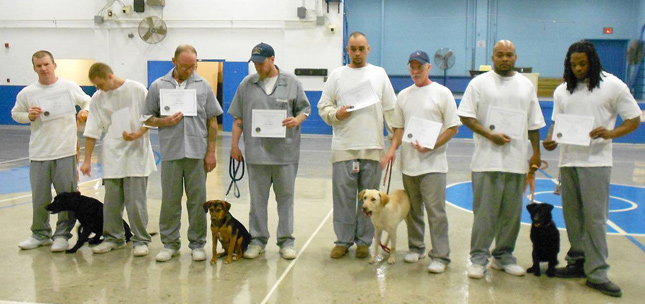For One Deaf Dog, Parole Meant a Fresh Start
Published on January 06, 2014

Life has not always been easy for Sparky (née Zeus) the Dachshund.
In fact, his story rivals Little Orphan Annie’s: The pup was born deaf to a breeder, who had little use for an impaired charge. Sparky narrowly escaped being euthanized and ended up at a shelter, where no one would adopt him because of his challenges.
That’s when an unlikely turn of events changed his life forever: Sparky went to jail.
More specifically, Sparky was enrolled in Puppies for Parole, an inmate dog-training program that launched in 2010 under George Lombardi, director of the Missouri Department of Corrections.
The Program’s Beginning
Initially, Lombardi was approached by a St. Louis-based organization called C.H.A.M.P. (or Canine Helpers Allow More Possibilities), which suggested that female inmates might be able to help train their service dogs. They ended up helping more than 60 pups and countless prisoners.

The experience was so positive that, in 2010, the now prison director sat down with Missouri’s 20 wardens and floated the idea of partnering on a larger scale with local shelters to have offenders of both genders help train dogs, rendering them more adoptable. “I was so impressed not only by the output of all these great dogs, but also by the effect of the experience on the inmates and the prison culture as a whole,” he enthuses. “Unfortunately, our state has a real puppy mill problem, so the shelters are overrun.”
The state’s most senior warden — in charge of the oldest prison west of the Mississippi — stepped up right away to join, and incrementally the others followed suit. The first Puppies for Parole dog walked into the maximum-security Jefferson City Correctional Center on Feb. 1, 2010. Six months ago, the 19th prison came on board. (The 20th is a Diagnostic Center and isn’t really an option.)
Puppies for Parole in Action
At last count, Missouri’s Puppies for Parole program has helped train, socialize and AKC (American Kennel Club) certify more than 2,200 dogs, and it's the only program in the country with every applicable prison involved. “The program helps dogs who may be about to be euthanized or have been stuck unadopted in shelters for a long time,” Lombardi says. “They’re not aggressive animals, but they might be three-legged, blind or deaf. We had two who were shot in the side of the head that the guys helped nurse back to health.”
Puppies for Parole receives food thanks to support from a local Royal Canin dog food plant manager. Generally, two inmates live together with a crated dog in their cell, so — based on guidance and mentoring from volunteer outside trainers — they care for the animal constantly: That means teaching house training, socialization with people and eventually other dogs in a designated area, trust exercises, leash walking and commands. The basic program lasts eight to 12 weeks, though some pups require two cycles.

Lombardi describes the service as a kind of “restorative justice program,” a way for offenders to give back to the community. But it also seems to promote compassion in the prisoners themselves. “Dogs don’t care who you are or that you went to prison; they just love you,” he notes. That can be an invaluable relationship for those who feel disenfranchised.
Several of the facilities hold regular graduation events for the dogs. In some cases, they even make caps for the pups, and the ceremony involves an inmate handler removing his leash from the dog’s collar and letting the new adopter slip theirs on. “It’s very touching,” Lombardi says. “The inmates take great pride in the dogs’ transformations into beautiful pets, who will respond to commands and love their families. We’ve even had offenders speak, like at high school commencements. Very powerful words.”

Thanks to support from the Department of Mental Health, Puppies for Parole — funded entirely by donations, as opposed to taxpayer money — won the 2010 Governor’s Award for Quality and Productivity in Innovation. Judy Finnegan, who worked as a kind of liaison between the two departments, was the nominator. “I really believe in how animals can promote mental health,” she explains. “I’ve seen it firsthand. I felt we needed to support this program and get dogs into our facilities and even adopted by our clients.”
Advanced Puppies for Parole
In concert with corrections, Finnegan has helped place dogs in mental health facilities, veterans’ homes, nursing homes, and prison hospice units and infirmaries.
About a year ago, she retired from state government and went to work as vice president of Human Animal Interaction at Comtrea Community Help Center (a treatment and service center for the abused and mentally ill). Comtrea began partnering with corrections on an Advanced Puppies for Parole, through which 10 percent of the program's dogs are trained as helpers for people with disabilities or illnesses. “In addition to socializing dogs to be great pets, we saw that some of them were turning into great search and rescue dogs or helpers for families with autistic members or people in wheelchairs,” says Finnegan, who has three of her own pups at home, including a retired guide dog. “Now we help facilitate adoptions, too.”
The Advanced program (which launched officially in June 2013) is more involved, including a uniform training curriculum that can take between one and six months. “Often service dogs are bred as puppies and pampered and well-trained from the beginning, but they tend to be very expensive with long waiting lists,” Finnegan says. “Thank God we have those programs, but ours is different in that we get dogs who have been abused, neglected or injured. It’s pretty miraculous to turn those into service dogs in a matter of months.” The dogs may be trained to wake up parents in the night if an autistic child leaves the house or to stay in close proximity to someone with PTSD, for example.
Sparky’s Training
Adorable Dachshund Sparky presented a chance to think outside the box. A shelter in Texas County approached the maximum-security prison in Licking, Mo., about a little deaf dog they were hoping could be trained. At first, the handlers didn’t know where to begin. They conferred with deaf inmates, who suggested stomping on the floor and using those vibrations to get his attention. The offenders managed to teach him eight to 10 signs and helped him pass the AKC certification test. Success!
More than half the dogs have been adopted by prison staff. But Sparky, with his rare black and white coloring and blue eyes, was notably adorable. And his story had a special impact.

A New Home
Ultimately, the inmates chipped in, paid the adoption fee and gifted Sparky to the Missouri School for the Deaf. The superintendent there, Barbara Garrison, already had three Dachshunds of her own, so it was a perfect fit. That’s where they changed his name from Zeus to Sparky (it's easier to sign), and he became an instant and integral part of the community. “We all knew it would be good for the kids to have a dog, but what is so profound is that these kids are learning to communicate with signs,” Finnegan says. “A regular pet isn’t going to understand them. What we found is that when a kid would respond to Sparky and Sparky would actually obey, it was like, 'Wow. I can communicate with the world.'”
Garrison instated special programs whereby students could apply to spend special time with Sparky — like overnight visits at the dorms or home visits on weekends. (Students stay at the school Monday through Friday.) Garrison took him around to different departments on campus, too, so that the kids could bond.
Assistant Superintendent Margilee LaBorde witnessed Sparky’s impact firsthand. “Sparky is a really cute dog. A lot of our kids have pets at home, but, of course, they can’t bring them to school,” LaBorde explains. “Here, during overnight visits, they would feed Sparky his supper and take him in and out as needed. A lot of the kids formed special bonds.”

Sparky was Puppies for Parole’s first deaf dog. Then, a colleague with a deaf daughter (twin to a hearing boy) wanted to adopt a dog who could understand signs. After training that family’s dog, the offenders made a book about canine signing for the brother so he could help his sister communicate. The program has also since helped two blind and deaf Australian Shepherds, who have been trained via touch and smell. One, Windsor, is now the house dog at one of the maximum-security prisons.
These Days
The program, going strong, now offers a video for adopters to keep up their training at home, and some inmates on parole have begun looking into employment in dog training, so it continues to give back. “We want it to self-sustain after we leave,” Lombardi says.
As for Sparky, Garrison just retired from her superintendent position and, at the urging of her students, is taking Sparky with her. Over the years, she has been his primary caretaker, and he has formed an undeniable attachment. The school hopes to continue the program with a new pup perhaps. Still, all agree, no one could ever replace Sparky.





